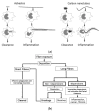Biocompatibility and Carcinogenicity of Carbon Nanotubes as Biomaterials
- PMID: 32033249
- PMCID: PMC7075247
- DOI: 10.3390/nano10020264
Biocompatibility and Carcinogenicity of Carbon Nanotubes as Biomaterials
Abstract
With the development of nanotechnology in recent years, there have been concerns about the health effects of nanoparticles. Carbon nanotubes (CNTs) are fibrous nanoparticles with a micro-sized length and nano-sized diameter, which exhibit excellent physical properties and are widely studied for their potential application in medicine. However, asbestos has been historically shown to cause pleural malignant mesothelioma and lung cancer by inhalation exposure. Because carbon nanotubes are also fibrous nanotubes, some have raised concerns about its possible carcinogenicity. We have reported that there is no clear evidence of carcinogenicity by local and intravenous administration of multi-walled CNTs to cancer mice models. We firmly believe that CNTs can be a safe, new, and high-performance biomaterials by controlling its type, site of administration, and dosage.
Keywords: biocompatibility; carbon nanotubes; carcinogenicity.
Conflict of interest statement
The authors declare no conflict of interest.
Figures







Similar articles
-
Pleural translocation and lesions by pulmonary exposed multi-walled carbon nanotubes.J Toxicol Pathol. 2020 Jul;33(3):145-151. doi: 10.1293/tox.2019-0075. Epub 2020 Mar 13. J Toxicol Pathol. 2020. PMID: 32764839 Free PMC article. Review.
-
Genotoxicity and carcinogenicity risk of carbon nanotubes.Adv Drug Deliv Rev. 2013 Dec;65(15):2098-110. doi: 10.1016/j.addr.2013.05.011. Epub 2013 Jun 7. Adv Drug Deliv Rev. 2013. PMID: 23751780 Review.
-
Carcinogenicity of multi-walled carbon nanotubes: challenging issue on hazard assessment.J Occup Health. 2018 Jan 25;60(1):10-30. doi: 10.1539/joh.17-0102-RA. Epub 2017 Oct 18. J Occup Health. 2018. PMID: 29046510 Free PMC article.
-
Carcinogenicity evaluation for the application of carbon nanotubes as biomaterials in rasH2 mice.Sci Rep. 2012;2:498. doi: 10.1038/srep00498. Epub 2012 Jul 9. Sci Rep. 2012. PMID: 22787556 Free PMC article.
-
Review of toxicity studies of carbon nanotubes.J Occup Health. 2017 Sep 28;59(5):394-407. doi: 10.1539/joh.17-0089-RA. Epub 2017 Aug 8. J Occup Health. 2017. PMID: 28794394 Free PMC article. Review.
Cited by
-
Perspectives on Nanomaterials and Nanotechnology for Sustainable Bioenergy Generation.Materials (Basel). 2022 Nov 3;15(21):7769. doi: 10.3390/ma15217769. Materials (Basel). 2022. PMID: 36363361 Free PMC article. Review.
-
Nanotube breakthroughs: unveiling the potential of carbon nanotubes as a dual therapeutic arsenal for Alzheimer's disease and brain tumors.Front Oncol. 2023 Sep 20;13:1265347. doi: 10.3389/fonc.2023.1265347. eCollection 2023. Front Oncol. 2023. PMID: 37799472 Free PMC article. Review.
-
Hydrogel-based nanoparticles: revolutionizing brain tumor treatment and paving the way for future innovations.Eur J Med Res. 2025 Feb 4;30(1):71. doi: 10.1186/s40001-025-02310-2. Eur J Med Res. 2025. PMID: 39905470 Free PMC article. Review.
-
Doped Graphene Quantum Dots as Biocompatible Radical Scavenging Agents.Antioxidants (Basel). 2023 Jul 31;12(8):1536. doi: 10.3390/antiox12081536. Antioxidants (Basel). 2023. PMID: 37627531 Free PMC article.
-
Antioxidant and anti-inflammatory function of Eupatorium adenophora Spreng leaves (EASL) on human intestinal Caco-2 cells treated with tert-butyl hydroperoxide.Sci Rep. 2024 May 7;14(1):10509. doi: 10.1038/s41598-024-61012-7. Sci Rep. 2024. PMID: 38714697 Free PMC article.
References
-
- McSweeney P.C. The safety of nanoparticles in sunscreens: An update for general practice. Aust. Fam. Phys. 2016;45:397–399. - PubMed
-
- Morita T., Takami N. Nano Si cluster-SiOx-C composite material as high-capacity anode material for rechargeable lithium batteries. J. Electrochem. Soc. 2006;153:A425–A430. doi: 10.1149/1.2142295. - DOI
-
- Aagaard J. The Carbomedics aortic heart valve prosthesis: A review. J. Cardiovasc. Surg. (Torino) 2004;45:531–534. - PubMed
-
- Morice M.C., Bestehorn H.P., Carrie D., Macaya C., Aengevaeren W., Wijns W., Dubois C., de Winter R., Verheye S., Hoffmann S., et al. Direct stenting of de novo coronary stenoses with tacrolimus-eluting versus carbon-coated carbostents. The randomized JUPITER II trial. EuroIntervention. 2006;2:45–52. - PubMed
Publication types
LinkOut - more resources
Full Text Sources

